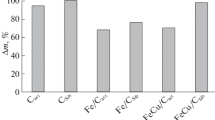Abstract
The rate of reduction of Fe2O3 and FeO by coconut charcoal, coal char and coke, in an inert atmosphere within the temperature range 900 to 1200°C was investigated. The effects of pressure, particle size, and the amount of carbon were determined. The results indicate that the reaction takes place by means of the gaseous intermediates CO and CO2, and that the overall rate is controlled by the oxidation of the carbon by CO2. The rates of reduction of FeO and Fe2O3 by CO are relatively fast, and the CO2/CO ratio for the oxidation of carbon is determined by their equilibria. The reduction of Fe2O3 by carbon is accomplished in two stages, with FeO forming first. The reduction of Fe2O3 to FeO is faster than that of FeO to Fe because its CO2/CO equilibrium ratio is higher and hence the rate of oxidation of carbon is faster. A direct comparison was made between the rate constants for the reduction of FeO by carbon and those for the oxidation of carbon in the appropriate CO2-CO gas mixtures, and they are in good agreement. Apparently the iron formed by the reduction does not significantly catalyze the oxidation of carbon; whereas for the reduction of NiO by carbon, the Ni formed does catalyze the oxidation of carbon.
Similar content being viewed by others
References
B.C. Baldwin:J. Iron Steel Inst., 1955,vol. 179,pp. 30–36.
T. S. Yun:Amer. Soc. Metals Trans. Quart., 1961, vol. 54, pp. 129–41.
H. K. Kohl and B. Marincek:Arch. Eisenhuetten., 1967, vol. 38, pp. 493–500.
Y. K. Rao:Met. Trans., 1971, vol. 2, pp. 1439–47.
H. Y. Sohn and J. Szekel:Chem. Eng. Sci., 1973, vol. 28, pp. 1789–1801.
N. S. Srinivason and A. K. Lahiri:Met. Trans. B, 1975, vol. 6B, pp. 269–74.
E. T. Turkdogan and J. V. Vinters:Carbon, 1970, vol. 8, pp. 39–53.
E.T. Turkdogan and J.V. Vinters:Met. Trans., 1972, vol. 3, pp. 1561–73.
1. J. Lin and Y. K. Rao:Inst. Mining Met., Trans. Sect. C, 1975, vol. 84, pp. C76–82.
E. T. Turkdogan and J. V. Vinters:Inst. Mining Met., Trans. Sect. C, 1976, vol. 85, pp. Cl17–23.
T. Turkdogan and J. V. Vinters:Carbon, 1972,vol. 10,pp. 97–111. $
Author information
Authors and Affiliations
Rights and permissions
About this article
Cite this article
Fruehan, R.J. The rate of reduction of iron oxides by carbon. Metall Trans B 8, 279–286 (1977). https://doi.org/10.1007/BF02657657
Received:
Issue Date:
DOI: https://doi.org/10.1007/BF02657657



